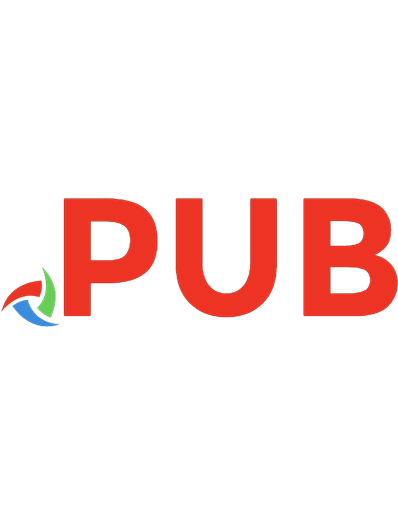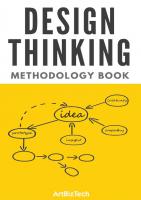Design Thinking - The Handbook 2019005287, 9789811202148, 9789811203503
1,297 437 86MB
English Pages 307 Year 2021

- Author / Uploaded
- Falk Uebernickel
- Li Jiang
- Walter Brenner
- Britta Pukall
- Therese Naef
- Bernhard Schindlholzer
- Categories
- Business
Table of contents :
CONTENTS
Imprint
Dedication
This book
Setup: Introduction and reading instructions
Thank you!
1 METHOD OVERVIEW
What is Design Thinking?
The micro-cycle — how design thinkers work
OVERVIEW
Practical
Reflection in action
Tame and wicked problems
Creativity
Visual and interactive
PROBLEM DEFINITION AND REDEFINITION
Vertical division
Horizontal adjustment
NEED FINDING AND SYNTHESIS
IDEATION
PROTOTYPING
TESTING
The macro-process: the 7+1 phases of design thinking
OVERVIEW
Design space exploration
Critical function prototype / critical experience prototype
Dark horse prototype
Funky prototype (integrated prototype)
Functional prototype
X-is-finished prototype
Final prototype
The paper bike…
DESIGN SPACE EXPLORATION
What does the team know, and what doesn’t it know yet?
Benchmarks
Patents and further information sources
Business models and start-up screening
Trend scouting
CRITICAL FUNCTION PROTOTYPE AND CRITICAL EXPERIENCE PROTOTYPE
Critical function prototype (CFP)
Critical experience prototype (CEP)
DARK HORSE PROTOTYPE
FUNKY PROTOTYPE (INTEGRATED PROTOTYPE)
FUNCTIONAL PROTOTYPE
X-IS-FINISHED PROTOTYPE
FINAL PROTOTYPE
The design thinking toolbox
The design thinking code
Jurisprudence
Behavior
Children and young people
Voluntariness
Personal rights
Breach of purpose
Transparency and objectivity
Anonymity
Safeguarding data (access protection)
Data destruction
The team
Personality type
Multidisciplinarity
T-profile
Openness
Experimentation
Help
Individuality
Criticism
Be childlike
Implementation in companies
The operational level of the project’s daily routine
The strategic level of transformation
Awareness
Experimental
Catch-up
Design thinking as an organizational culture
2 TOOLKIT
Setup
PROJECT PLANNING
Visionary projects
Development projects
The project outline
Scheduling on the basis of the macro-cycle
Timing
Financial resources
INFRASTRUCTURE
TEAM SETUP
Personality type
Multidisciplinarity
T-profile
Sources
POST-ITS
Advantages
What should we pay attention to?
DNA ANALYSIS METHOD
How did this method emerge?
What is the essence of the method?
Key points of the method:
What will it achieve?
What’s it about?
The process:
Experiences with the method
Testimonials
Problem definition and redefinition
DEFINING THE QUESTION STATEMENT
Do not offer solutions
Inspiration and emotion
Give a direction
Developing guidelines
STRETCH GOALS
FRAMING AND REFRAMING
The reframing process is carried out in three steps (see Morgan, G., 1997):
GET INSPIRATION FROM THE FUTURE
Need finding and synthesis
NEED FINDING CYCLE
GUIDELINES FOR EXPRESSING NEEDS
SAMPLING TECHNIQUES
Purposive sampling
Quota sampling
Snowball sampling
TARGET GROUP IDENTIFICATION
FOCUS GROUPS
INTERVIEWS
OBSERVATION
ENGAGEMENT
BENCHMARKING
FRAMEWORKS
FIELD NOTES
MOODBOARD
AEIOU
EMPATHY MAP
NETNOGRAPHY
PERSONA
WHY-HOW LADDERING
5 WHYS
POINT OF VIEW
LEAD USER
CAMERA STUDY
Ideation
BRAINSTORMING
BRAINWRITING
SIX THINKING HATS/LATERAL THINKING
POWER OF TEN
HOW MIGHT WE
Prototyping and storytelling
PROTOTYPING
WIREFRAMING
MOCK-UPS
OPEN HARDWARE
ROLEPLAY
BODYSTORMING
PAPER PROTOTYPING
STORYTELLING AND STORYWRITING
COMICS
RAPID 3D PROTOTYPING
VIDEO PROTOTYPING
SERVICE BLUEPRINTING
SKETCHES AND SCRIBBLES
PHOTOSHOP PROTOTYPING
COMBINED PROTOTYPING
TOWN PLANNING
BUSINESS MODEL PROTOTYPES
CONFLUENCE DYNAGRAM
Testing
CONSUMER CLINICS
USABILITY TESTING
NABC PITCH
PECHAKUCHA
NEED-FINDING TECHNIQUES
Warm-ups
SPAGHETTI TOWER
YES BUT, YES AND
RACES
ASSEMBLY
STICK FIGURES
Feedback
I LIKE, I WISH, WHAT IF
PLUS OR DELTA
FEEDBACK CAPTURE GRID
CRITICAL READING CHECKLIST
Declaration of consent
3 THE DESIGN THINKING LAB
Creative spaces
Inspiration from the environment
Inspiration through communication
Golden rules for design thinking spaces
Workspaces for design thinking
Individual or team
Assigned or open workspaces
Quadrant 1: Assigned individual workspaces
Closed offices
Workstations
Open office
Quadrant 2: Your own team workspace
Closed team room
Open team area
Quadrant 3: Open group area
Prototyping rooms and areas
Workspaces
Meeting areas
Rooms for relaxation and inspiration
Quadrant 4: Flexible individual workspaces
Setting up design thinking workspaces
Ad-hoc design thinking spaces
Design thinking lab
Design thinking floor
Design thinking culture
Realization of design thinking workspaces
AD-HOC DESIGN THINKING WORK AREAS
DESIGN THINKING LAB
Workshops and training
Short-term projects
DESIGN THINKING FLOOR
DESIGN THINKING ORGANIZATION
Design thinking material list
Design thinking tools
Design thinking furniture
4 APPLICATION IN ORGANIZATIONS
Design thinking in everyday projects
DESIGN THINKING AS A TOOLKIT
DESIGN THINKING AS PART OF THE INNOVATION PROCESS
DESIGN THINKING FOR USER ORIENTATION AND INNOVATION
Levels of organizational transformation
Level 1 — Awareness
Level 2 — Experimental
Level 3 — Catch-up
Level 4 — Design and Customer-oriented Innovation
Recommended actions and success factors for the implementation of design thinking
Customer and user orientation
Management commitment
Lighthouse projects
Sharpening perception and understanding
Selection and focus
Stamina
Break up silo structures
Small teams
Spaces
5 CASE STUDIES
DEUTSCHE BANK
Short description of the company
What were the catalysts for starting to use de sign thinking?
How do you define design thinking?
What happened with your project results?
What have you learned through design thinking and about design thinking up to this point?
How do you want to continue using design thinking?
What advice would you give to other organizations?
SWISSCOM
Short description of the organization
What were the catalysts for starting with design thinking?
How do you define design thinking?
What happened with the results of your projects?
What have you learned through and about design thinking up to this point?
How do you want to continue using design thinking?
What recommendations do you have for other organizations?
HAUFE-LEXWARE
MARIGIN
How did design thinking flow into this project?
Who was involved?
What was the concrete procedure?
What was the most relevant outcome of the DNA analysis?
How was design thinking implemented?
What was unique in the process?
What do we need to pay attention to?
How will this design thinking attitude continue in the organization?
MEDELA
What is the innovation culture of the organization?
Market research and insights
Research
How does one bring insights, engineering and research together, whether divided in terms of place, content or culture?
How could the process be established?
Who is part of the process?
What is needed for implementation?
How does the procedure run?
How can the design thinking culture become anchored and visible within an organization?
Design thinking and architecture
6 APPENDIX
BIBLIOGRAPHY
INDEX









